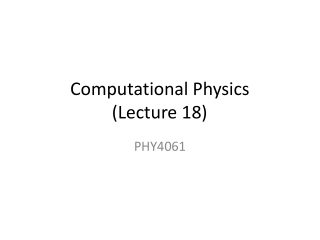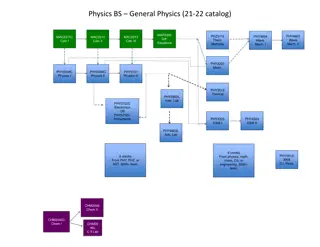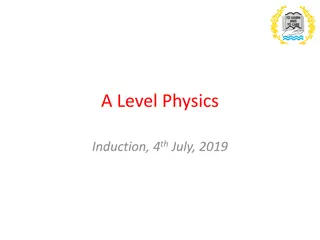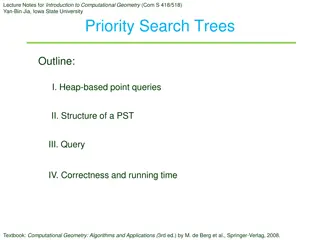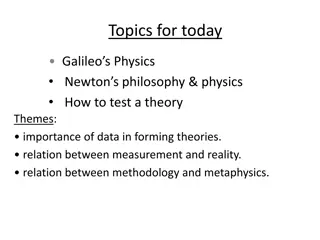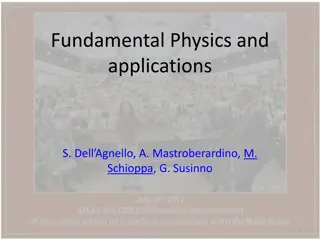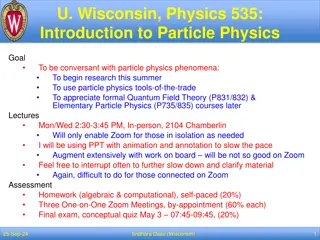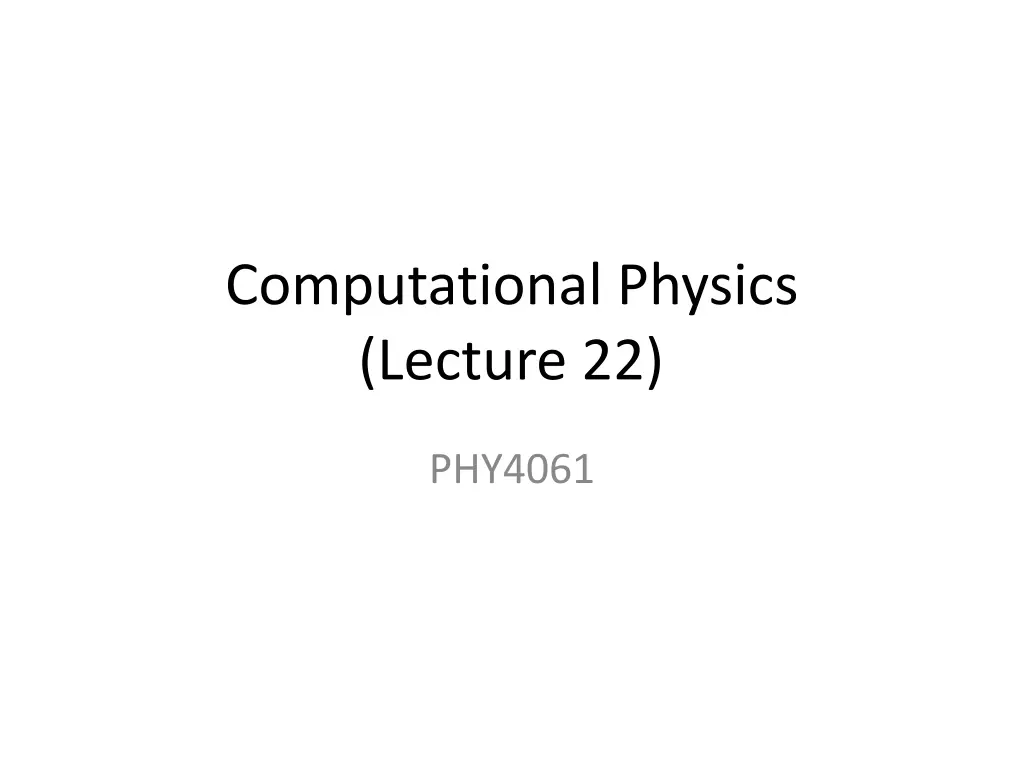
Density Functional Theory in Computational Physics
Explore the foundations and history of Density Functional Theory (DFT) in computational physics, its role in understanding correlated many-body systems, and its applications in calculating electronic structures of condensed matter and molecules. Learn about the development of DFT since the groundbreaking papers by Hohenberg, Kohn, Mermin, and Sham, and how it has become a primary tool for theoretical material studies.
Download Presentation

Please find below an Image/Link to download the presentation.
The content on the website is provided AS IS for your information and personal use only. It may not be sold, licensed, or shared on other websites without obtaining consent from the author. If you encounter any issues during the download, it is possible that the publisher has removed the file from their server.
You are allowed to download the files provided on this website for personal or commercial use, subject to the condition that they are used lawfully. All files are the property of their respective owners.
The content on the website is provided AS IS for your information and personal use only. It may not be sold, licensed, or shared on other websites without obtaining consent from the author.
E N D
Presentation Transcript
Computational Physics (Lecture 22) PHY4061
Density functional theory: foundations DFT is a theory of correlated many-body systems. In close association with independent-particle methods, Because it has provided the key step that has made possible development of practical, useful independent-particle approaches Incorporate effects of interactions and correlations among the particles.
DFT has become the primary tool for calculation of electronic structure in condensed matter Increasingly important for quantitative studies of molecules and other finite systems. Remarkable successes of the approximate local density and generalized-gradient approximation functionals within the Kohn-Sham approach Led to wide spread interest in DFT as the most promising approach for accurate, practical methods in the theory of materials.
History The modern formulation of DFT: Originated in a famous paper written by P. Hohenberg and W. Kohn in 1964. A special role can be assigned to the density of particles in the ground state of a quantum many- body system: the density can be considered as a basic variable. All properties of the system can be considered to be unique functionals of the ground state density
In 1965, Mermin extended the Hohenberg-Kohn arguments to finite temperature canonical and grand canonical ensembles. The finite temperature extension hasn t been widely used Generality of DFT and the difficulty of realizing the promise of exact DFT. So there could be chances for future development. In 1965, A classic work by W. Kohn and L. J. Sham, whose formulation of DFT has become the basis of much of present day methods for treating electrons ion atoms, molecules and condensed matter.
Thomas-Fermi-Dirac approximation: example of a functional Thomas and Fermi proposed in 1927 The original density functional theory of quantum systems. Their approximation is not accurate enough for present day electronic structure calculations. The approach illustrates the way density functional theory works.
In the original Thomas Fermi method, the kinetic energy term is approximated as an explicit functional of the density, idealized as non-interacting electrons in a homogeneous gas with density equal to the local density at any given point. Exchange and correlation are neglected. In 1930, Dirac extended the theory. Formulated the local approximation for exchange. Still in use today!
An energy functional for electrons in an external potential Vext(r) ???[n]=?1 ?3??(?)5/3+ ?3? ????? ? ? + ?2 ?3? ? ?4/3 + ?3? ?3? ? ? ? (?)/|? ? | The first term is the local approximation to the kinetic energy, with C1 = 3/10 (3 2)(2/3)=2.871 in atomic units. The third term is the local exchange with C2 = -3/4(3/ )(1/3)for the case of equal up and down spins and the last term is the classical electrostatic Hartree energy.
The ground state density and energy can be found by minimizing the functional E[n] for all possible n(r)subject to the constrain on the total number of electrons: ?3r n(r)=N. Using the Lagrange multipliers, the solution can be found by an unconstrained minimization of the functional ??[n] = E??[n] { ?3r n(r) N} Where the Lagrange multiplier is the Fermi energy.
For small variations of the density n(r), the condition for a stationary point is: ?3r{ ??[n(r)+ n(r)]- ??[n(r]} -> ?3r{5 Where V(r) = Vext(r)+ Vhartree(r)+Vx(r) is the total potential. The above equation has to satisfy any function n(r) it follows that the functional is stationary if and only if the density and potential satisfy the relation: (3 2)(2/3)n(r)2/3+V(r)- =0. 3?1n(n)2/3+V(r)- } n(r)=0
Extensions to account for effects of inhomogeneity have been proposed by many people. For example by Weizsacker correction: (?n (r))2/n (r). Recent correction was found to be 1/36(?n (r))2/n (r).
The attraction of density functional theory is evident by the fact that one equation for the density is remarkably simpler than the full many body Schrodinger equation that involves 3N degrees of freedom for N electrons. However, this approach starts with approximation that are too crude, missing essential physics and chemistry, such as shell structures of atoms and binding of molecules. Thus it falls short of the goal of a useful description of electrons in matter!
The Hohenberg-Kohn Theorems The approach of Hohenberg and Kohn is to formulate DFT as an exact theory of many body systems. The formulation applies to any system of interacting particles in an external potential Vext(R), including any problem of electrons and fixed nuclei, where the Hamiltonian can be written: H = - 2/ 2?? ???2+ ?????(??)+1/2 ? ??2/|?? ??|
Density functional theory is based upon two theorems first proved by Hohenberg and Kohn. Theorem I: For any system of interacting particles in an external potential Vext(r), the potential Vext(r) is determined uniquely, except for the constant, by the ground state particle density n0(r).
Corollary I: Since the Hamiltonian is thus fully determined, except for a constant shift of the energy, it follows that the many-body wave- functions for all states (ground and excited) are determined. Therefore all properties of the system are completely determined given only the ground state density n0(r).
Theorem II : A universal functional for the energy E[n] in terms of the density n(r) can be defined, valid for any external potential Vext(r). For any particular Vext(r), the exact ground state energy of the system is the global minimum value of this functional, and the density n(r) that minimizes the functional is the exact ground state density n0(r).
Corollary II: The functional E[n] alone is sufficient to determine the exact ground state energy and density. In general, excited states of the electrons must be determined by other means. Mermin showed that thermal equilibrium properties, such as specific heat, are determined directly by the free-energy functional of the density.
Proof of Theorem I: density as a basic variable Very simple Consider first theorem I, using the general expressions for the density and energy in terms of the many body wave function. Suppose that there were two different external potentials, V(1) and V(2) which differ by more than a constant and which lead to the same ground state density n(r). The two external potentials lead to two different hamiltonians, H(1) and H(2), which have two different wave functions (1) and (2), which have the same ground state density n0(r).
Since (2) is not the ground state of H(1), E(1) = < (1)|H(1)| (1)> < < (2)|H(1)| (2)>. This inequality follows if the ground state is non- degenerate, which we will assume here following the arguments of Hohenberg and Kohn. < (2)|H(1)| (2)> = < (2)|H(2)| (2)> + < (2)|H(1) H(2)| (2)> = E(2) + ?3?[? 1 ? ?(2)(?)]n0(r), So that, E(1) < E(2) + ?3?[? 1 ? ?(2)(?)]n0(r)
Treat the E(2) with the same way, we have: E(2) < E(1) + ?3?[? 2 ? ?(1)(?)]n0(r), If we add together, we have E(1) + E(2) < E(1) + E(2)! Therefore, there can t be two different external potentials differing by more than a constant which give rise to the same non- degenerate ground state charge density.
The corollary follows since the hamiltonian is uniquely determined by the ground state density. Then, in principle, the wavefunction of any state is determined by solving the Schrodinger equation with this hamiltonian. Among all the solutions which are consistent with the given density, the unique ground state wavefunction is the one that has the lowest energy.
Despite the appeal of this result, it is clear from the reasoning that no prescription has been given to solve the problem. Since all that was proved is that n0(r) uniquely determines Vext(r), we are still left with the problem of solving the many body problem in the presence of Vext(r).
For example, for electrons in materials, the external potential is the Coulomb potential due to the nuclei. The theorem only requires that the electron density uniquely determines the positions and types of nuclei. At this level, we have gained nothing! We are still facing the original problem of many interacting electrons moving in the potential due to the nuclei!
Proof of Theorem II The second theorem is just as easily proven! Once one has carefully defined the meaning of a functional of the density and restricted the space of densities. The original proof of H-K is restricted to densities n(r) that are ground state densities of electron hamiltonian with same external potential Vext.
This defines a space of possible densities within which we can construct functionals of the density. Since all properties such as the kinetic energy, etc., are uniquely determined if n(r) is specified, then each such property can be viewed as a functional of n(r), including the total energy function: E[n] = T[n] + Eint[n] + ?3?????? ?(?)+Eii=FHK[n] + ?3?????? ?(?)+Eii
Eiiis the interaction energy of the nuclei. The functional FHK[n] includes all internal energies, which must be universal by construction since the kinetic energy and interaction energy of the particles are functionals only of the density. Now consider a system with the ground state density n(1) (r) corresponding to external potential Vext(r). Following the discussion above, the HK functional is equal to the expectation value of the hamiltonian in the unique ground state, which has the wave function (1), E(1) = EHK[n(1)] = < (1)|H(1)| (1)>
Now consider a different density, n2(r), which corresponds to a different wavefunction (2). It follows immediately that the energy E(2) of this state is greater E(1), since E(1) = < (1)|H(1)| (1)> < < (2)|H(1)| (2)> = E(2). Thus the energy in terms of the HK functional evaluated for the correct ground state density n0 is indeed lower than the value of this expression for any other density n(r).
It follows that if the functional FHK[n] was known, then minimizing the total energy of the system, with respect to variations in the density function n(r), one would find the exact ground state density and energy. This establishes Corollary II. The functional only determines the ground state properties; it doesn t provide any guidance concerning excited states.
Constrained search formulation of density functional theory An alternative definition of a functional due to Levy and Lieb is very instructive Extends the range of definition of the functional in a way that is formally more tractable and clarifies its physical meaning; Provides an in-principle way to determine the exact functional; Leads to the same ground state density and energy at the minimum as in the Hohenberg-Kohn analysis, and also applies for degenerate ground states.
The idea of Levy and Lieb (LL) is to define a two step minimization procedure beginning with the usual general expression for the energy in terms of the many-body wave function . The ground state can be found by minimizing the energy with respect to all the variables in .
However, suppose one first considers the energy only for the class of many-body wavefunctions That can have the same density n(r). For any wavefunction, the total energy can be written E= < |T| > +< | Vint| > + ?3?????? ?(?).
If one minimizes the energy over the class of wavefunctions with the same density n(r), then one can define a unique lowest energy for that density: ELL[n] = lim ] ???? > + ?3?????? ?(?)+EII = Fll n + ?3?????? ?(?)+EII ELLis manifestly a functional of the density and the ground state is found by minimizing ELL[n]. ?(?)[ < ? >+<
It clarifies that: the minimum of the sum of kinetic plus interaction energies for all possible wavefunctions having the given density n(r). The LL functional is defined for any density n(r) derivable from a wavefunction for N electrons. N representability vs. V respresentability. At a minimum of the total energy of the system in a given external potential, LL must equal the HK functional. LL also removes the restriction in the original proof of HK to non-degenerate ground states.
A functional can be defined for any density, and that by minimizing this functional, one would find the exact density and energy of the true interacting many-body system. No method has been given to find the functional other than the original definition in terms of many body wave functions.
Extensions of Hohenberg-Kohn theorems Spin density functional theory HK theorems can be generalized to several types of particles. The reason for the special role of the density and the external potential in the HK theorems, rather than some other properties of the particles, is simply that these quantities enter the total energy explicitly only through the integral term of Vext. If there are other terms in the hamiltonian having this form, then such pair of external potential and particle density will obey a HK theorem.
The most relevant example for our purposes is a Zeeman term that is different for up and down spin fermions. Magnetic field that acts only on the spins, not on the orbital motions. One of the important effects of an external magnetic field, so that this can be considered as a physically realistic approximation.
Within this model, one can rigorously generalize all the above arguments to include two types of densities, the particle density n(r) = n(r, up) + n(r, down), and the spin density s(r) = n(r, up) n(r, down). This leads to an energy functional: E = EHK[n,s] = EHK [n] In the last form, it is assumed that [n] denotes a functional of the density which depends upon both position in space r and spin.
Spin density functional theory is essential in the theory of atoms and molecules with net spins, as well as solids with magnetic order. Need extension to include magnetic field upon orbital motion. In the absence of external Zeeman fields, the lowest energy solution may be spin polarized. Up spin is not equal to down spin. The broken symmetry solution of unrestricted Hartree-Fock theory.
The original HK theorem remains valid and the ground state, in principle, is determined by the total ground state density n(r) = n(r, up) +n(r,down) for any system where there is no spin dependent external potential.
Mermin finite temperature and ensemble density functional theory The theorems of Hohenberg and Kohn for the ground state carry over to the equilibrium thermal distribution by constructing the density corresponding to the thermal ensemble. For each of the conclusions of Hohenberg and Kohn for the ground state, there exists a corresponding argument for a system in thermal equilibrium, as was shown by Mermin.
To show this, Mermin constructed a grand potential functional of the trial density matrices ? , ? = ??[? ? ? + 1 ln? ] , whose minimum is the equilibrium grand potential: = ?0 = ln?? ? ?(? ?), Where ?0 is the grand canonical density matrix ?0 =? ?(? ?)/Tr ? ?(? ?).
The proof is analogous to the Hohenberg-Kohn proofs and uses only the minimum property of ? and the fact that the energy depends upon the external potential only through the Vext integral. The Mermin theorem leads to even more powerful conclusions than the Hohenberg-Kohn theorems, Namely that not only the energy, but also the entropy, specific heat, etc., are functionals of the equilibrium density.
However, the Mermin functional has not been widely applied. The simple fact it is much more difficult to construct useful, approximate functionals for the entropy (which involves sums over excited states) than for the ground state energy. For example, in the Fermi liquid description of a metal the specific heat coefficient at low temperature is directly related to the effective mass at the Fermi surface. Thus the Mermin functional for the free energy must correctly describe the effective mass (with all its many- body renormalization) as well as the ground state energy.
Current functionals From the beginning, the HK theorems assumed that the Hamiltonian is time reversal invariant. If there is a magnetic field, the density is not enough The properties of the system are a functional of both the density and the current density. The theory is not as well developed as that for current density.
Time dependent density functional theory The Hohenberg-Kohn theorem have also been extended to the time domain, where it has been shown that, given the initial wavefunction at one time, the evolution at all later times is a unique functional of the time dependent density. There has recently been considerable progress along these lines.
It has recently been pointed out that in an extended system, i.e. one with no boundaries, the evolution is not a functional only of the density. A simple counter example is a uniform ring of charge that can flow around the ring. Since the density is always uniform, the state of the system is determined only if an extra condition, the current, is specified.
Electric fields and polarization The issue of electric fields and polarization comes into play in extended systems. In finite space, the potential due to an electric field V = Ex is unbounded; There is no lower bound to the energy and therefore there is no ground state! This is a famous problem in the theory of the dielectric properties of materials. However, if the ground state does not exist, the HK theorems on the ground state do not apply.
Is there any way to include an electric field in DFT? Very subtle problem and the answer is that in the presence of an electric field, one must apply some constraint, within which there is a stable ground state. In the case of molecules, this is routinely done simply by constraining the electrons to remain near the molecules. In a solid, the constraint is not so obvious. All proposals involve constraining the electrons to be in localized Wannier functions or equivalent conditions on Bloch functions.

